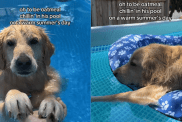You’ve head it from your doctor, your nutrition-savvy friends, and TV commercials for high-fiber breads and cereals: People need more fiber in their diet. But do you know the role that fiber plays in the digestive process? And did you ever stop to consider that dogs also need fiber in their diet?
Let’s take a look at what happens during digestion and how fiber helps.
Digestion: The inside story
Food gets broken down into small pieces that can be absorbed and used by the body in a process called “digestion.” In mammals, this process takes place in the digestive or alimentary tract, often simply called the “gut.” The gut is basically a hollow tube that food passes through. In this tube, food is acted upon by various enzymes and acids that break it down to release the nutrients dogs (and people) require.
The major classes of nutrients that need to be digested are carbohydrates, protein, and fat. Other nutrients—such as minerals and vitamins—are also digested and absorbed in the gut, but in smaller quantities.
The first steps in the digestive process
Digestion begins in the mouth, where food is mechanically broken down and mixed with saliva before it’s swallowed. The sight and smell of food stimulates the flow of saliva, causing the dribbling and “lip smacking” often seen at mealtime. Once the food arrives in the mouth, its taste and physical presence help increase saliva production. Saliva contains mucus, a very effective lubricant that coats the food to help with swallowing. Chewing is also an important part of the process because it aids in reducing the size of food particles in preparation for digestion.
Next stop: The stomach
When food is swallowed, it passes down the esophagus, and arrives at the stomach within a few seconds. The stomach has several functions. It’s a temporary storage organ; it’s a mixer (where digestive enzymes are added to the food); and it’s a regulator valve that controls the flow of nutrients into the small intestine. Protein digestion begins in the stomach.
Stomach secretions contain protein-digesting enzymes (proteases), hydrochloric acid, and mucus. The acid provides an environment in which the enzymes work best. Mucus lubricates the food, and protects the lining of the stomach wall from being digested by its own enzymes. The secretion of acid, mucus, and enzymes depends on the composition and quantity of food eaten, and is regulated by hormones and nerves.
The stomach contents are mixed thoroughly to form a milky liquid called chyme, which is then passed into the duodenum (the first part of the small intestine).
Inside the intestines
The duodenum is the main site for digestion in the small intestine. Here, more enzymes—from the intestinal wall and the pancreas—are added to the chyme. Pancreatic juice also contains sodium bicarbonate, which neutralizes the acidic chyme that arrives in the duodenum. These juices provide an alkaline environment for optimal functioning of pancreatic and intestinal enzymes. Bile from the liver, which aids in fat digestion, is also secreted into the duodenum.
The small intestines are very long, and absorption takes place along its entire length. Folds and finger-like projections, called villi, in the lining of the intestinal wall dramatically increase the surface area for absorption. In some dogs, the absorptive area of the small intestine may be as large as the floor of a small room!
The digestion of food is completed in the small intestine, and once the food has been broken down to its simplest form, it can be absorbed across the wall of the intestine and into the blood, where it can be used or stored by the body.
By the time food reaches the large intestine, the useable nutrients have been digested and absorbed. In this part of the gut, water is absorbed, and bacterial fermentation takes place on some of the undigested food. There are many types of bacteria in the large intestine. The right types of bacteria are important for keeping the large intestine healthy. Some fermentation results in the production of gas, associated with flatulence.
Feces are around 60–70% water, and the rest is made up of undigested food, dead bacteria, and some inorganic material. The feces are stored in the rectum and evacuated through the anal sphincter.
What is fiber and why is it so important?
Fiber’s importance is touted so often, it’s easy to forget that many people probably really don’t know much about it. Here are a few quick fiber facts:
• Fiber is a type of carbohydrate.
• There are two types of dietary fiber: soluble and insoluble. Soluble fiber is not able to be digested by your dog, but is fermented as a food source by bacteria in the large intestine. Insoluble fiber, which is not fermentable or digestible at all, provides bulk and helps waste products move through the large intestine to be excreted. This type of fiber is generally made up of plant cell walls.
• A balanced canine diet should include both types of fiber.
• Common sources of fiber in dog food include grains, beet pulp, and chicory.
The benefits of fiber to your dog’s health are many and varied. Research indicates that meals rich in certain types of soluble fiber may lead to increased digestibility, which means that your dog can utilize more of the nutrients in his food with less waste for you to scoop up.
Here’s a closer look at more of the benefits fiber provides for your dog.
Weight management. Foods that are higher in fiber can decrease the calorie density of the diet, and have a tendency to make dogs feel fuller. As a result, their hunger is satisfied by eating less calories—which means they can walk away from their meal happy, without overloading on calories.
Improved stool quality. You will likely see an improvement in the quality of your dog’s stool when you feed him a high-fiber diet. A “high quality” stool is one that is well-formed and solid (but not too hard) vs. one that is loose. And we don’t have to tell which poop is easier to scoop when you walk your dog.
Help with anal sac glands. The glands around a dog’s anus produce a secretion that is stored in two anal sacs, one on each side of the anus. Each sac has a duct that can become impacted. When this happens, you may notice your dog scooting his rear across the floor or constantly licking the area around his anus. Dogs perform those behaviors in an effort to relieve the discomfort and pressure of full anal sacs. Insoluble fiber promotes bulkier stool formation, and this puts pressure on the sacs, helping them express themselves naturally to help prevent future problems.
Make sure your dog gets an appropriate amount of fiber
Because dietary fiber can help your dog in so many ways, look for food that—in addition to being complete and balanced—also has a sufficient level of fiber. The PEDIGREE® Brand has reformulated all its dry foods with a new blend of dietary fiber that contains optimal levels of both soluble and insoluble fiber. In addition, the overall digestibility of the PEDIGREE® Brand recipes have been improved, resulting in more nutrients for your dog with less waste cleanup. This reformulation was based on research conducted by WALTHAM, THE WORLD’S LEADING AUTHORITY ON PET CARE AND NUTRITION®.









